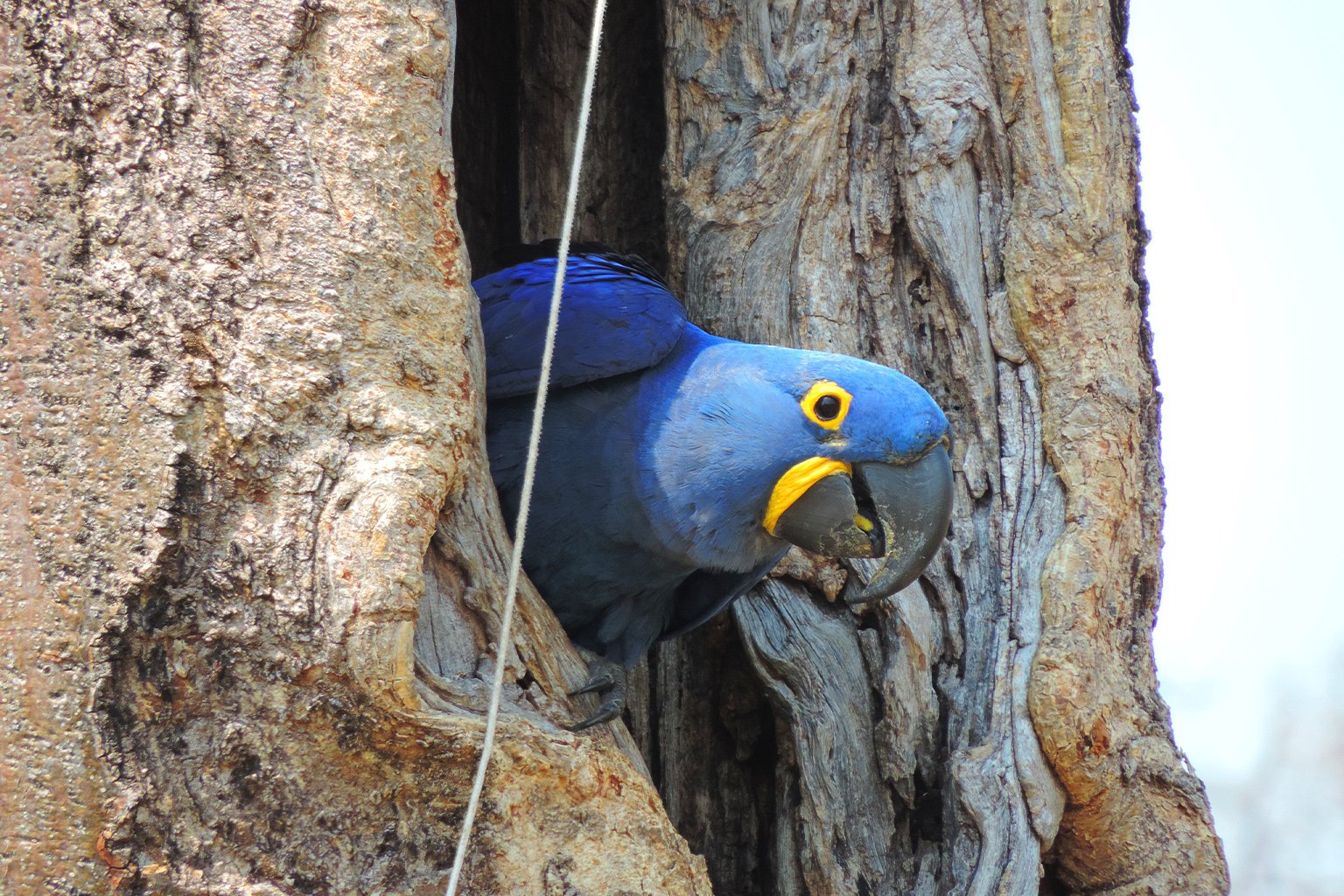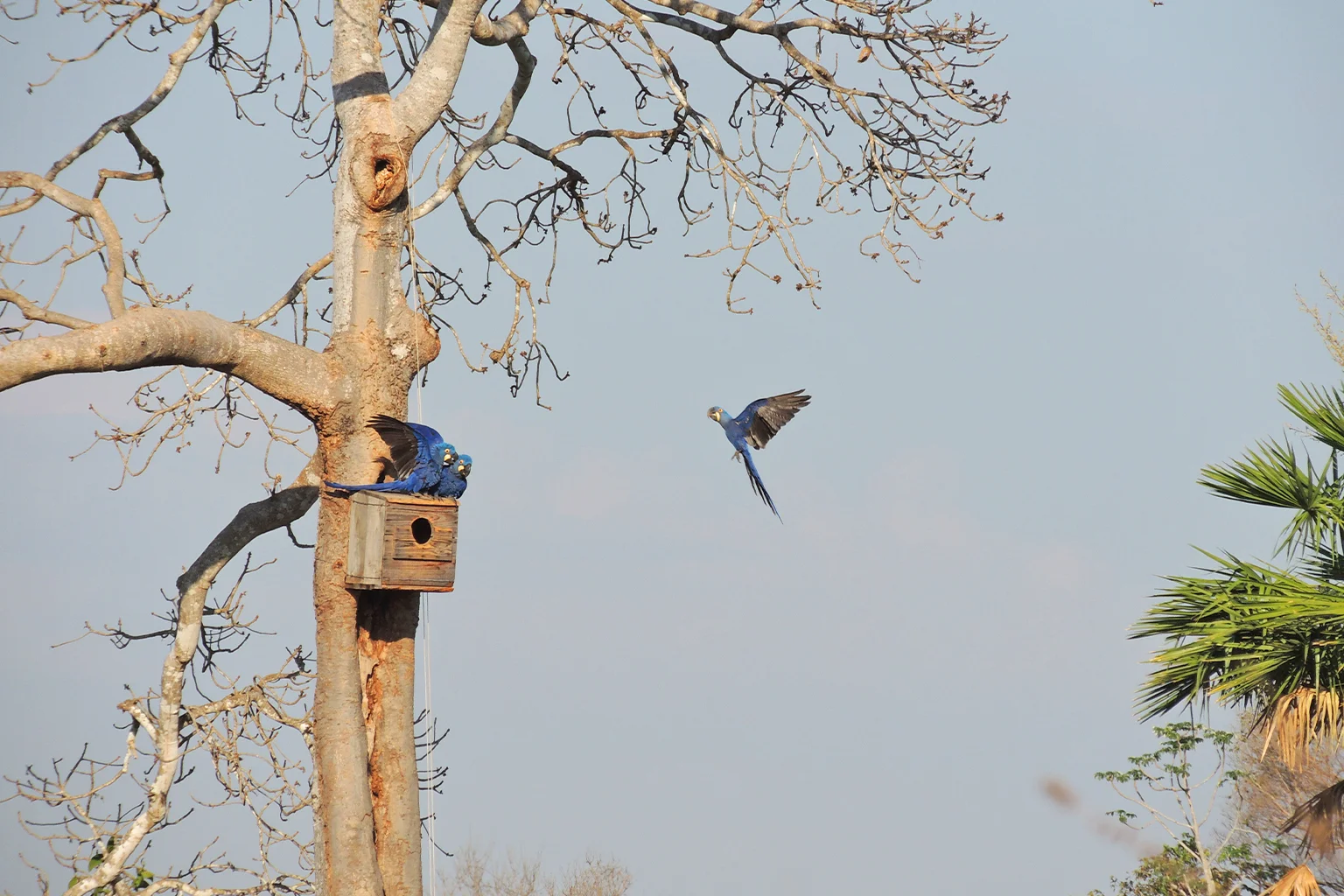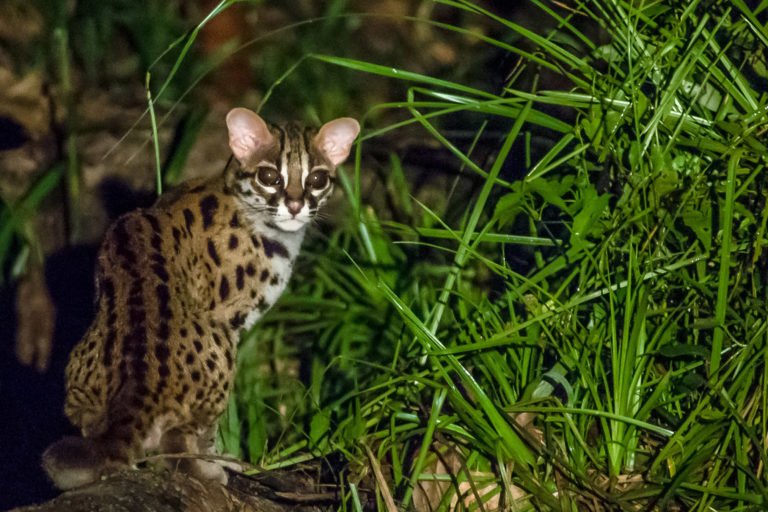- The hyacinth macaw, the world’s largest flying parrot, is closer to return to Brazil’s endangered species list, less than a decade after intensive conservation efforts succeeded in getting it off the list.
- The latest assessment still needs to be made official by the Ministry of the Environment, which is likely to publish the updated endangered species list next year.
- Conservation experts attribute the bird’s decline to the loss of its habitat due to fires in the Pantanal wetlands and ongoing deforestation in the Amazon and Cerrado biomes.
- Climate change also poses a serious threat, subjecting the birds to temperature swings that can kill eggs and hatchlings, and driving heavy rainfall that floods their preferred nesting sites.
Less than a decade since conservation actions helped pull the hyacinth macaw out of Brazil’s endangered species list, the iconic cobalt-blue bird is back in the red, driven there by the loss of its habitat and a changing climate.
Brazil’s National Center for Research and Conservation of Wild Birds (Cemave) updated the bird’s category, from vulnerable, at the end of April, following an assessment conducted with outside experts of the species’ extinction risk based on IUCN Red List criteria.
The hyacinth macaw (Anodorhynchus hyacinthinus) remains in the vulnerable category on the IUCN Red List, which assesses its conservation status across its global range, which includes Bolivia and Paraguay.
The change to endangered status in Brazil isn’t official yet. Cemave still needs to submit its findings to the National Biodiversity Commission for analysis and approval of the change to the hyacinth macaw’s place in the National List of Endangered Species. There’s no deadline, however, for these steps to be completed. The last edition of the list was published on June 7, and includes species that were assessed between 2015 and May 2021.
“That year, the data showed that the conservation efforts, carried out especially by the Hyacinth Macaw Institute, were keeping the largest population of this species, located in the Pantanal biome, in a safer condition,” Priscilla do Amaral, the Cemave coordinator, told Mongabay by phone. “It is not comfortable being in the vulnerable category, but compared to the previous situation, we had a more optimistic scenario.”
Between 2000 and 2013, the hyacinth macaw, the world’s largest flying parrot, was classified as an endangered species in Brazil. Its conservation status improved to vulnerable in 2014, according to the IUCN. Its decline now is due to the loss of habitat in its range in Brazil: in the Pantanal wetlands, the Cerrado savanna, and the Amazon rainforest.
“The perception of those who work in the field and have known the species and its environment for decades is that the pressures are higher,” Amaral said. “This is supported by a scientific work published last year and by calculations we made about the macaw’s habitat loss with technology tools such as Google Engine and MapBiomas.”
The Ministry of the Environment, which publishes the National List of Endangered Species, told Mongabay in an email that it plans to publish an updated list every year. Since the latest one was published in June this year, it’s most likely that the next one, which could include the hyacinth macaw, will be released in 2023.
Conservation experts say the rising frequency and intensity of fires in the Pantanal and the ongoing deforestation in the Amazon and central Brazil are the main drivers of habitat destruction in recent years. The Pantanal, home to 70% of hyacinth macaws in Brazil, saw 28% of its total area hit by fires in 2020, according to the Laboratory of Environmental Satellite Applications at the Federal University of Rio de Janeiro. A technical report by the Public Ministry of Mato Grosso and Mato Grosso do Sul, the states that are home to the Pantanal, showed that nearly 60% of the fire outbreaks that year were related to farming activities.

Fire in the wetlands
Living in flocks, the hyacinth macaw population is concentrated in Mato Grosso do Sul, in particular in the Caiman Ecological Sanctuary. That’s where the Hyacinth Macaw Institute has been based since 1998. Sprawled across 54,000 hectares (133,400 acres), the site is also a breeding center for the macaws and has about 110 nests, both natural and artificial. In the 2019 fires, 35,000 hectares (86,500 acres) of the site were burned, and macaw eggs and hatchlings were lost.
A key roosting site for the birds, where they gather in huge numbers to sleep, was outside the São Francisco do Perigara ranch in Mato Grosso. The Hyacinth Macaw Institute, which has monitored the site since 2004, counted more than 1,000 individual birds there in the past. But in August 2020, 90% of the property burned, and the macaws dispersed.
“In April [2022], our last count, there were only 227 macaws,” Neiva Guedes, president and founder of the Hyacinth Macaw Institute, told Mongabay by phone. “It was a traditional place for the species for over 60 years. After the fires, most did not return to sleep in the area again.”
The Pantanal fires resulted in food scarcity, disrupting the natural functioning of the ecosystem and leaving the macaws vulnerable to predators such as the weasel-like tayra (Eira barbara) that would otherwise have gone after other prey, Guedes said.

“Animals that took advantage of remains left by the hyacinth macaw could no longer do so, and tayras even ate adult macaws, which has never happened before,” she said. “There are changes we still don’t understand, as well as their impacts.”
In 2008, there were 6,500 hyacinth macaws in Brazil, more than three-quarters of them in the Pantanal. That marked a dramatic reversal from a low of 2,500 in 1987. Trafficking of the birds for the illegal pet trade up until the 1980s was estimated to have taken more than 10,000 hyacinth macaws from the wild.
“Precise numbers are difficult to obtain, especially after the last fires,” said Guedes, who has worked on hyacinth macaw research and conservation since 1994. “This year, we will try to estimate with the collaboration of international researchers.”
Smaller populations of hyacinth macaws are also found in Bolivia (home to about 150 birds in 2000) and in the Paraguay section of the Pantanal.
A more hostile climate
The hyacinth macaw is a large bird that can measure up to 1 meter (3.3 feet) from beak to tail tip and live an average of 50 years. It’s also one of the most at-risk macaw species: It has a low reproductive rate (the female usually lays only two eggs per cycle on average), and its breeding period, from August to October, coincides with the dry season in the Pantanal, when fires occur.
“Last year, we quickly removed four chicks from two artificial nests at the Caiman farm until the fire died,” Guedes said. “Otherwise, they would have died intoxicated from the smoke.”
The bird has a very particular diet centered on native species of palm trees. In the Pantanal region, it only eats the fruit of the acuri (Attalea phalerata) and bocaiúva (Acrocomia aculeata) trees. When they nest, they do so almost exclusively in cavities in the manduvi tree (Sterculia apetala), which has a soft core.
Climate change has also affected the birds’ reproduction. “Some years ago, it used to rain the same volume of water for 20, 30 days. Now it concentrates in a short period, and the water ends up flooding the cavities, especially the natural ones,” Guedes said. “With the flooded nests, chicks drown, and the eggs, which need the incubation of the female for embryo development, have their cycle interrupted.”

Changes in temperature are another negative factor in the region. The average temperature in the Pantanal is 35° Celsius (95° Fahrenheit), but last year it reached 43°C (109°F) in the shade and dropped to 7°C (45°F) in less than 24 hours. Those extreme swings can kill both eggs and hatchlings.
“Animals are at the mercy of climate extremes. When these variations happen very quickly, they don’t have time to adapt,” Guedes said. “It may be obvious to say this, but unlike us, animals don’t have coats, air conditioning or technology to defend themselves.”
Despite the rapid changes in the hyacinth macaw’s habitat, Guedes said her institute and its partners remain positive in the fight to save the species, collecting data to support public policies and training more people to help with conservation. “We must be persistent and join efforts to accomplish much more, to help save biodiversity, which includes mankind,” she said.
Amaral echoed the sentiment. “If we give nature a chance, it recovers, which is why I believe in conservation efforts,” she said. “It is a colossal struggle because it is necessary to understand that the benefits will come in the future for everyone, which is not natural for human beings who seek immediate advantages for themselves or their group. This mindset shift is crucial.”
Citation:
Oliveira, M. R., Szabo, J. K., Santos Júnior, A. D., Guedes, N. M., Tomas, W. M., Camilo, A. R., … Garcia, L. C. (2021). Lack of protected areas and future habitat loss threaten the Hyacinth Macaw (Anodorhynchus hyacinthinus) and its main food and nesting resources. Ibis, 163(4), 1217-1234. doi:10.1111/ibi.12982
FEEDBACK: Use this form to send a message to the author of this post. If you want to post a public comment, you can do that at the bottom of the page.












